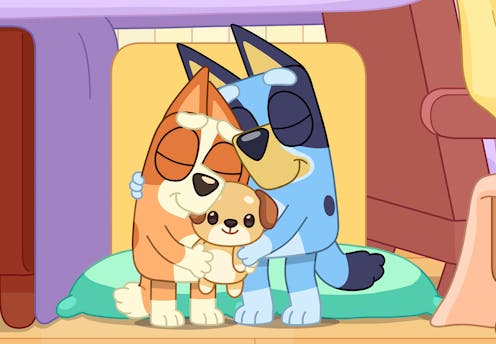Why are adults without kids hooked on Bluey? And should we still be calling it a ŌĆśkidsŌĆÖ showŌĆÖ?
- Written by Jessica Balanzategui, Senior Lecturer in Media, RMIT University

ŌĆ£Bluey maniaŌĆØ shows no sign of abating. BlueyŌĆÖs season finale, The Sign, was the most viewed ABC program of all time on iView.
A ŌĆ£hiddenŌĆØ follow-up episode, aptly named The Surprise, created a storm of headlines around the world, many of which have a decidedly adult tone.
As highlighted in social media fan communities and articles, the show has struck a chord with adults, many of whom arenŌĆÖt parents. What do they get from a show that is ostensibly ŌĆ£for kidsŌĆØ?
Parents love Bluey (sometimes more than kids)
Our research with children aged 7-9 and their parents provides evidence of how enraptured adults are by Bluey. Our findings also suggest itŌĆÖs the parents who often drive household Bluey obsessions.
As one mum told us:
If we could tell the Australian TV gods something that weŌĆÖd like to have on Australian TV, it would be more Bluey, donŌĆÖt get rid of Bluey. [ŌĆ”] Bluey is loved by mums a lot.
Another explained how the show provided learning for parents:
ItŌĆÖs the gentle parenting, kindness, empathy for the children, the humour [ŌĆ”] And helping kids [and] families work through real life situations with kindness and compassion.
When one eight-year-old and his mum told us about their favourite shows, the following exchange took place:
Mum:: What about Bluey? Son: I sometimes [watch it]ŌĆ” Mum: You donŌĆÖt want to say. He doesnŌĆÖt want to say he watches Bluey. BlueyŌĆÖs fantastic. Son: I sometimes- Mum: He wants to be a big boy. [ŌĆ”] Everyone in this room probably loves Bluey. ItŌĆÖs not just for kids. Son: Enough about that.
Beyond families, Bluey has also attracted teen and adult fans without kids ŌĆō in part thanks to a vibrant TikTok community (aka #blueytok). While some commentary suggests this adult fandom is ŌĆ£weirdŌĆØ, Bluey is only the latest in a long line of ŌĆ£childrenŌĆÖsŌĆØ shows with a passionate adult fanbase.
Shifting barriers in television
The distinction between ŌĆ£childrenŌĆÖsŌĆØ and ŌĆ£adultŌĆØ television has long been crucial to our cultural understandings of what separates a child from an adult.
In the 1950s, academics were concerned children were watching TV content that was too mature for them, turning them into ŌĆ£adultised childrenŌĆØ, and that adults watching kidsŌĆÖ shows were becoming ŌĆ£infantile adultsŌĆØ.
The industry took note. In 1957, a reduction in childrenŌĆÖs TV production in the United States made space for so-called ŌĆ£kidultŌĆØ shows designed for both age groups.
Since then, the boundaries between childrenŌĆÖs and adult television have continually shifted. In televisionŌĆÖs early days, science fiction was associated with child audiences (which is why many initially assumed Star Trek was a kidsŌĆÖ show).
These boundaries were also influenced by television scheduling. Warner BrosŌĆÖ early animation shorts were initially all-ages theatrical releases, but in 1960 were packaged into the Bugs Bunny Show ŌĆō pitched for kids and aired on Saturday mornings. As a result, by 1967 animation was considered kidsŌĆÖ fare.
The boundaries shifted again in the 1980s as adult Japanese anime such as Akira (1988) became popular in the West.
In 1989, The Simpsons debuted on TV. Our research reveals even today there is confusion regarding the showŌĆÖs suitability for young children. Some of our seven-to-nine-year-old participants described secretly watching it without their parentsŌĆÖ knowledge.
Childhood healing
BlueyŌĆÖs adult appeal is credited to the showŌĆÖs playful yet emotionally complex content. One reason adults tune into todayŌĆÖs kidsŌĆÖ TV is because itŌĆÖs far more diverse than the shows they could access growing up.
Take 19-year-old Bluey fan Darby Rose, who points to an episode in which a Jack Russell terrier has ADHD. ŌĆ£As a neurodivergent person myself, this representation makes me ecstatic,ŌĆØ Rose says. This is also true of many teen programs, with the queer-friendly high-school romance Heartstopper attracting a large adult following.
ItŌĆÖs not just childhood nostalgia that drives adults to kidsŌĆÖ shows (although this is one aspect). Watching kidsŌĆÖ shows can be self-affirming for adults who missed out on seeing their identity onscreen growing up. Some adult fans even say Bluey has helped them heal childhood wounds.
ChildrenŌĆÖs television meets adult fan cultures
Watching ŌĆ£adultŌĆØ television enables kids to feel more grown-up. Conversely, adults can watch childrenŌĆÖs television to embrace aspects of their personality they feel social pressure to repress.
The latter is often the case for ŌĆ£BroniesŌĆØ (a portmanteau for ŌĆ£broŌĆØ and ŌĆ£ponyŌĆØ): adult male fans of the animated kidsŌĆÖ show My Little Pony: Friendship is Magic (2010-20). The community has attracted much controversy. But research has found the reasons behind being a Brony arenŌĆÖt suspicious or bizarre, but are empowering in unexpected ways.
As Bronies themselves have explained, the fandom allows them to rethink what masculinity means to them, with the support of other fans online and at events such as BronyCon.
Why canŌĆÖt ŌĆ£manlinessŌĆØ include watching a cute show about ponies with friendship at its heart?
The changing nature of childrenŌĆÖs television
The rise of streaming has led to yet another shift. On-demand viewing means freedom from the constraints of TV scheduling, which historically set the terms for ŌĆ£childŌĆØ and ŌĆ£adultŌĆØ viewing.
As our book details, Netflix has invested in the expansion of cultural expectations around what makes ŌĆ£child-appropriateŌĆØ television.
NetflixŌĆÖs mega hit Stranger Things deliberately pushes at these boundaries to attract a wide audience, from children and teens, to families, to adults without kids. As co-creator Matt Duffer explains, the aim was to get children hooked on the show, and then later in the season ŌĆ£scare the shit out of them. Then the parents can get mad.ŌĆØ
Parents certainly arenŌĆÖt mad about their children getting hooked on Bluey. They may even be the secret to its global success: to keep the children watching, get the adults hooked.
Authors: Jessica Balanzategui, Senior Lecturer in Media, RMIT University



















